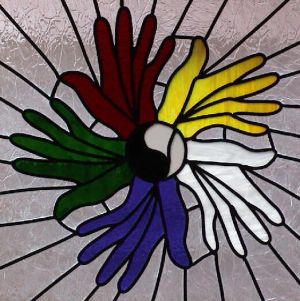|
Meridians
* Channels * Vessels
The body's
energy, or Qi, flows through channels just like
blood flows through the arteries and veins. These
channels, vessels, and Meridians all have different pathways, origins
and destinations, but they all contain the Qi. The different names are
used to identify certain schools of thought with which they are associated
or originate, but they all mean the same kind of thing:
a closed-circuit pathway that contains and distributes the Qi.
The different meridian systems all interact to form a fantastically
complex network which creates and maintains
all body organs, systems, and functions.
Some examples
are:
- 12 Traditional Channels
- Zen Shiatsu Meridians
- Internal Meridians,
Divergent Channels
-
Extraordinary Vessels
|
|

|
Traditional
Chinese Medicine (TCM) presents us with the 12
Traditional Channels or Meridians.
These ancient pathways have been used for millennia by acupuncturists
and Tuina(Chinese massage) practitioners, and more recently by Shiatsu
practitioners. Each meridian travels only on the body's surface; each
is associated with and named for a vital internal organ; each belongs
to one of the Five Elements; each is classified further into a Yin/Yang
polarity and therefore has a 'Sister' meridian, always of the same Element.
Since there are two(Yin/Yang) of each element(5 x 2 = 10), we achieve
the number 12 by adding an extra Yin/Yang pair of Fire Element meridians.
This is in part because the Heart belongs to the Fire Element, and while
each element has an emotion which may manifest when it is imbalanced,
the Heart governs all emotion and exerts more influence upon all emotions;
and therefore has more importance. This is reflected anatomically in
Western medicine: you can take out part or all of many of the internal
organs, but you can't live without a fully functioning heart. We also
add the extra, or Secondary Fire meridians (a complement to the Primary
Fire meridians)
in part to incorporate TCM concepts into the meridian system, and as
a reflection of the two stages of the heartbeat.
The 12 traditional
Meridians, in order of their Qi flow, are:
Metal Element:
Lung, Large Intestine
Earth Element: Stomach, Spleen/Pancreas
Primary Fire Element: Heart, Small Intestine
Water Element: (Urinary) Bladder, Kidneys
Secondary Fire Element: Pericardium, Triple Warmer
Wood Element: Gall Bladder, Liver
The Secondary Fire meridians are not entirely associated with internal
organs. The Yin channel is called the Pericardium, or Heart Protector,
or Heart Constrictor, or Circulation/Sex meridian; it is primarily a
protector/backup/support for the Heart and all its functions, and is
also related in theory to reproduction. The Fire Element's Secondary
Yang channel is called the Triple Warmer, or Triple Heater meridian,
and is associated with the immune system and our Wei
Qi.
The meridian
system begins with the Lung and ends with the Liver.
If a organ isn't listed here, then it falls into a subcategory of one
of these meridians.
The Qi flows from the beginning of the meridian, through the acupoints
and changes in its trajectory, to the end of the meridian; but never
leaves the network of channels. The Qi flows from one meridian into
the next, picking up characteristics and influences from each associated
organ as it flows. As the Qi flows from one meridian into the next,
the meridians' element or polarity changes: the Qi either flows into
a different polarity within the same element, or into the same polarity
of a different element:
Metal: Yin
into Yang, then
Earth: Yang into Yin, then
Fire: Yin into Yang, then
Water: Yang into Yin, then
2nd Fire: Yin into Yang, then
Wood: Yang into Yin, then
starting over again with Metal.
The Zen
Shiatsu Meridians are extensions of and slight alterations to the
12 traditional meridians. This is done in part to make each treatment
more holistic: where some traditional meridians are for example only
found on the arm and torso, the Zen meridians are found on every part
of the body: head, torso, and all limbs- for every meridian. This way,
every treatment addresses the entire body surface and not just parts
of it. The Zen extensions also allow for more interaction
of certain meridians, through intersecting and nearby proximity. The
Zen Meridians follow more direct,
simplified trajectories which flow along and between the 12 traditional
meridians.
The Internal
Meridians are just what they sound like: at specific acupoints,
the Qi flow leaves the traditional meridian trajectory, penetrates the
body's surface and travels internally, more or less directly to, its
associated organ, and back to the tradtional meridians. There are acupoints
on every traditional meridian referred to as Entry and Exit points.
The Internal, or Divergent vessels, use these and other acupoints to
connect to the traditional meridians.
The Extraordinary
Vessels (EOV) are called such in part because each EOV can treat
several or all of the 12 traditional meridians at once. The 12 traditional
meridians are often likened to rivers; in this context, the EOV would
be considered lakes or reservoirs which supply the rivers as well as
collect their overflow. They are the pathways of the
Jing delivery and tonification, and are known
to produce extraordinary clinical results.
They are activated by connecting groups of acupoints found on the traditional
meridians.
|
|
An excellent, thorough overview
of Meridan trajectories and pathways is presented in
The Foundations of Chinese Medicine, by Giovanni Maciocia.
For more specific, technical,
detailed Meridian and Acupoint locations, see
Acupuncture: A Comprehensive Text, published by the Shanghai
College of Traditional Medicine.
|
